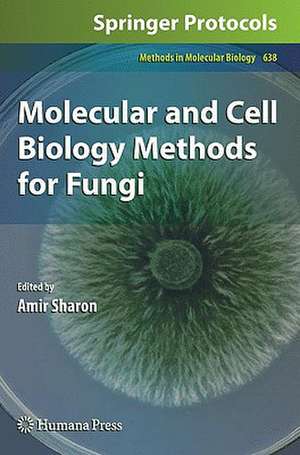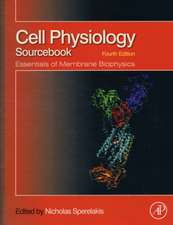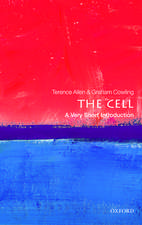Molecular and Cell Biology Methods for Fungi: Methods in Molecular Biology, cartea 638
Editat de Amir Sharonen Limba Engleză Hardback – 18 mar 2010
| Toate formatele și edițiile | Preț | Express |
|---|---|---|
| Paperback (1) | 702.87 lei 43-57 zile | |
| Humana Press Inc. – 23 aug 2016 | 702.87 lei 43-57 zile | |
| Hardback (1) | 957.13 lei 43-57 zile | |
| Humana Press Inc. – 18 mar 2010 | 957.13 lei 43-57 zile |
Din seria Methods in Molecular Biology
- 9%
 Preț: 791.59 lei
Preț: 791.59 lei - 23%
 Preț: 598.56 lei
Preț: 598.56 lei - 20%
 Preț: 882.95 lei
Preț: 882.95 lei -
 Preț: 252.04 lei
Preț: 252.04 lei - 5%
 Preț: 802.69 lei
Preț: 802.69 lei - 5%
 Preț: 729.61 lei
Preț: 729.61 lei - 5%
 Preț: 731.43 lei
Preț: 731.43 lei - 5%
 Preț: 741.30 lei
Preț: 741.30 lei - 5%
 Preț: 747.16 lei
Preț: 747.16 lei - 15%
 Preț: 663.45 lei
Preț: 663.45 lei - 18%
 Preț: 1025.34 lei
Preț: 1025.34 lei - 5%
 Preț: 734.57 lei
Preț: 734.57 lei - 18%
 Preț: 914.20 lei
Preț: 914.20 lei - 15%
 Preț: 664.61 lei
Preț: 664.61 lei - 15%
 Preț: 654.12 lei
Preț: 654.12 lei - 18%
 Preț: 1414.74 lei
Preț: 1414.74 lei - 5%
 Preț: 742.60 lei
Preț: 742.60 lei - 20%
 Preț: 821.63 lei
Preț: 821.63 lei - 18%
 Preț: 972.30 lei
Preț: 972.30 lei - 15%
 Preț: 660.49 lei
Preț: 660.49 lei - 5%
 Preț: 738.41 lei
Preț: 738.41 lei - 18%
 Preț: 984.92 lei
Preț: 984.92 lei - 5%
 Preț: 733.29 lei
Preț: 733.29 lei -
 Preț: 392.58 lei
Preț: 392.58 lei - 5%
 Preț: 746.26 lei
Preț: 746.26 lei - 18%
 Preț: 962.66 lei
Preț: 962.66 lei - 23%
 Preț: 860.21 lei
Preț: 860.21 lei - 15%
 Preț: 652.64 lei
Preț: 652.64 lei - 5%
 Preț: 1055.50 lei
Preț: 1055.50 lei - 23%
 Preț: 883.85 lei
Preț: 883.85 lei - 19%
 Preț: 491.88 lei
Preț: 491.88 lei - 5%
 Preț: 1038.84 lei
Preț: 1038.84 lei - 5%
 Preț: 524.15 lei
Preț: 524.15 lei - 18%
 Preț: 2122.34 lei
Preț: 2122.34 lei - 5%
 Preț: 1299.23 lei
Preț: 1299.23 lei - 5%
 Preț: 1339.10 lei
Preț: 1339.10 lei - 18%
 Preț: 1390.26 lei
Preț: 1390.26 lei - 18%
 Preț: 1395.63 lei
Preț: 1395.63 lei - 18%
 Preț: 1129.65 lei
Preț: 1129.65 lei - 18%
 Preț: 1408.26 lei
Preț: 1408.26 lei - 18%
 Preț: 1124.92 lei
Preț: 1124.92 lei - 18%
 Preț: 966.27 lei
Preț: 966.27 lei - 5%
 Preț: 1299.99 lei
Preț: 1299.99 lei - 5%
 Preț: 1108.51 lei
Preț: 1108.51 lei - 5%
 Preț: 983.72 lei
Preț: 983.72 lei - 5%
 Preț: 728.16 lei
Preț: 728.16 lei - 18%
 Preț: 1118.62 lei
Preț: 1118.62 lei - 18%
 Preț: 955.25 lei
Preț: 955.25 lei - 5%
 Preț: 1035.60 lei
Preț: 1035.60 lei - 18%
 Preț: 1400.35 lei
Preț: 1400.35 lei
Preț: 957.13 lei
Preț vechi: 1167.23 lei
-18% Nou
Puncte Express: 1436
Preț estimativ în valută:
183.15€ • 191.70$ • 152.44£
183.15€ • 191.70$ • 152.44£
Carte tipărită la comandă
Livrare economică 31 martie-14 aprilie
Preluare comenzi: 021 569.72.76
Specificații
ISBN-13: 9781607616108
ISBN-10: 1607616106
Pagini: 290
Ilustrații: XI, 321 p.
Dimensiuni: 178 x 254 x 25 mm
Greutate: 0.78 kg
Ediția:2010
Editura: Humana Press Inc.
Colecția Humana
Seria Methods in Molecular Biology
Locul publicării:Totowa, NJ, United States
ISBN-10: 1607616106
Pagini: 290
Ilustrații: XI, 321 p.
Dimensiuni: 178 x 254 x 25 mm
Greutate: 0.78 kg
Ediția:2010
Editura: Humana Press Inc.
Colecția Humana
Seria Methods in Molecular Biology
Locul publicării:Totowa, NJ, United States
Public țintă
Professional/practitionerCuprins
Fungal Transformation and Gene Knockout.- Protoplast Transformation of Filamentous Fungi.- Electroporation and Agrobacterium-Mediated Spore Transformation.- High-Throughput Construction of Gene Deletion Cassettes for Generation of Neurospora crassa Knockout Strains.- Development of Impala-Based Transposon Systems for Gene Tagging in Filamentous Fungi.- DelsGate: A Robust and Rapid Method for Gene Deletion.- Gene Silencing for Functional Analysis: Assessing RNAi as a Tool for Manipulation of Gene Expression.- Detection and Quantification of Fungi.- Analysis of Fungal Gene Expression by Real Time Quantitative PCR.- Identification of Differentially Expressed Fungal Genes In Planta by Suppression Subtraction Hybridization.- Quantification of Fungal Infection of Leaves with Digital Images and Scion Image Software.- Expression Profiling of Fungal Genes During Arbuscular Mycorrhiza Symbiosis Establishment Using Direct Fluorescent In Situ RT-PCR.- Application of Laser Microdissection to Study Plant–Fungal Pathogen Interactions.- Multiplex Gene Expression Analysis by TRAC in Fungal Cultures.- Amplification of Fungal Genomes Using Multiple Displacement Amplification.- Microscopy and Protein Analysis.- Biochemical Methods Used to Study the Gene Expression and Protein Complexes in the Filamentous Fungus Neurospora crassa.- Measuring Protein Kinase and Sugar Kinase Activity in Plant Pathogenic Fusarium Species.- A Detailed Protocol for Chromatin Immunoprecipitation in the Yeast Saccharomyces cerevisiae.- A Method to Visualize the Actin and Microtubule Cytoskeleton by Indirect Immunofluorescence.- Fluorescence In Situ Hybridization for Molecular Cytogenetic Analysis in Filamentous Fungi.- Live-Cell Imaging of Microtubule Dynamics in Hyphae of Neurospora crassa.- Methods to DetectApoptotic-Like Cell Death in Filamentous Fungi.- Evaluation of Antifungal Susceptibility Using Flow Cytometry.- Preparation of Fungi for Ultrastructural Investigations and Immunogoldlabelling.- Split-EGFP Screens for the Detection and Localisation of Protein–Protein Interactions in Living Yeast Cells.
Recenzii
From the reviews:
“This volume of methods and step-by-step protocols for fungal molecular biology deals with three areas: (i) fungal transformation and gene knockout; (ii) detection and quantitation of fungi; and (iii) microscopy and protein analysis. The authors of the chapters are world leaders in their respective fields and the book … still a valuable laboratory resource. … this is a good place for a freshman fungal lab worker to start - and it also provides a useful list of contacts who no doubt could field further questions.” (Neil A. R. Gow, Microbiology Today, 2010)
“This volume of methods and step-by-step protocols for fungal molecular biology deals with three areas: (i) fungal transformation and gene knockout; (ii) detection and quantitation of fungi; and (iii) microscopy and protein analysis. The authors of the chapters are world leaders in their respective fields and the book … still a valuable laboratory resource. … this is a good place for a freshman fungal lab worker to start - and it also provides a useful list of contacts who no doubt could field further questions.” (Neil A. R. Gow, Microbiology Today, 2010)
Textul de pe ultima copertă
With the development of fungal transformation systems and the deciphering of an increasing number of fungal genomes, this diverse clade of heterotrophic eukaryotic organisms has proven to be ideal for molecular work and highly serviceable as model systems to study basic processes with results that are applicable to many organisms, including humans. In Molecular and Cell Biology Methods for Fungi, experts in the field provide an up-to-date set of practical protocols covering a range of frequently used methods used to study molecular and cellular aspects of fungal biology. The included classical protocols such as transformation systems and traditional protein analysis methods, which have been widely used for many years, alongside the most advanced techniques such as genome amplification, whole genome knockout methods, and sophisticated in vivo imaging techniques will prove to be easily adaptable and useful in a wide range of species. Written in the highly successful Methods in Molecular Biology™ series format, chapters include introductions to their respective topics, lists of the necessary materials and reagents, step-by-step, readily reproducible laboratory protocols, and notes on troubleshooting and avoiding known pitfalls.
Comprehensive and up-to-date, Molecular and Cell Biology Methods for Fungi seeks to provide cutting-edge techniques in order to aid both experienced fungal research laboratories as well as those that are interested in using fungi as hosts to study their favorite genes.
Comprehensive and up-to-date, Molecular and Cell Biology Methods for Fungi seeks to provide cutting-edge techniques in order to aid both experienced fungal research laboratories as well as those that are interested in using fungi as hosts to study their favorite genes.
Caracteristici
Provides a comprehensive set of methods used in fungal molecular and cell biology written by leading researchers in the field Presents the most popular methods alongside highly advanced technologies Methods cover all types of molecular and cellular research from single cell analyses to high throughput methods Methods will prove invaluable to novice as well as experienced researchers Methods have been proven effective for a wide variety of fungal species Includes supplementary material: sn.pub/extras










